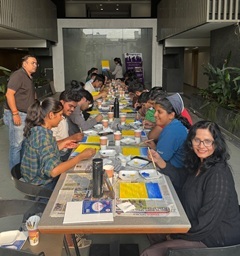Clay is a dirty beautiful 4 letter word

Chunar glaze pottery is a traditional form of pottery that originated in the town of Chunar in Uttar Pradesh, India. It is a unique style of pottery that is known for its striking glaze and intricate designs. Chunar glaze pottery has also received Geographical Indication (GI) tag .
The pottery is made of red clay and contains intricate designs made with silver paint. In some varieties glossy finish is achieved using a special powdery preparation called ‘kabiz.’ This powder is made using the soil taken from rice field.

History of Chunar Glaze Pottery
The history of Chunar glaze pottery can be traced back to the Mauryan period in India, which lasted from 321 BC to 185 BC. During this time, the town of Chunar was an important center for pottery production. The potters in Chunar were known for their skill in creating high-quality pottery, which was used for a variety of purposes, including storage, cooking, and decoration.
Techniques of Chunar Glaze Pottery
Over time, Chunar pottery began to evolve, and potters started experimenting with new techniques and styles. One of the most significant developments was the introduction of glaze, which gave the pottery a shiny, lustrous finish. The glaze was made by mixing powdered glass with clay, and then firing the pottery in a kiln at high temperatures.
Chunar glaze pottery is characterized by its intricate designs, which are often inspired by nature. The pottery is made using a variety of techniques, including throwing, coiling, and molding. Once the pottery has been shaped, it is dried in the sun, and then fired in a kiln.
The glaze is applied to the pottery using a brush, and then fired again in the kiln. The firing process is critical to the success of the glaze, as it must be fired at a high enough temperature to melt the glass and fuse it to the pottery.
Cultural implications
Chunar glaze pottery is an important part of Indian culture and heritage. It is valued for its beauty, durability, and functionality, and is used for a variety of purposes, including cooking, storage, and decoration.
In addition to its practical uses, Chunar glaze pottery also has symbolic significance. The intricate designs on the pottery are often inspired by nature, and are believed to represent the interconnectedness of all living things. The glaze itself is a symbol of purity and perfection, and is associated with spiritual and mystical qualities.
Chunar glaze pottery has also played a significant role in the economy of the region. The pottery is made by skilled artisans, many of whom have been practicing their craft for generations. The pottery is sold both locally and internationally, providing an important source of income for the community.
Current Status
In recent years, because of transportation and infrastructure issues, as the Chunar glaze pottery are fragile, artisans are leaving manufacturing of the same. Other work like plaster of paris based potteries especially from Khurja is replacing them.
Image credit

Create, Connect, Collaborate!
